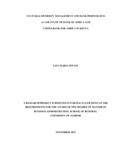| dc.description.abstract | The world has become a global village, and companies have increasingly expanded their markets across borders. Intensified internationalization of businesses has been achieved through cross- border mergers, alliances, acquisitions and joint ventures. Although banks in Kenya and the world at large are recognizing the importance of making workforce as broad and diversified as customers, many are faced with unique challenges in managing the culturally diverse workforce. The main objective of this study was to examine the relationship between cultural diversity management and bank performance, with a specific focus on international firms‟ subsidiaries in their host countries. The study adopted a case study research design, comparing results from United Bank for Africa and Bank of Africa. Data was collected using an interview guide. Data analysis was done using content analysis which was summarized according to common themes. The findings of the study indicated that the most common forms of cultural diversity in both banks are gender, age, religion and nationality. However, the levels of cultural diversity in the two institutions were found to vary. Further, the study established a relationship between cultural diversity management and performance, indicating that effective cultural diversity management led to better bank performance. Based on the findings of the study, the researcher recommended that for a multinational company to gain competitive advantage in a host country, cultural diversity management should form an integral part of their management activities. The study was found to have various implications for theory, knowledge, managerial practice, and managerial policy. There was value addition to the RBV theory in the effective application of heterogeneous internal resources to gain competitive advantage. Further, the upper echelons theory was supported by the finding that managers‟ decisions are affected by their cultural orientations and backgrounds. There seemed to be limited empirical data on local studies for cultural diversity management and bank performance. The study sought to contribute to a knowledge gap in the area of international business management within Africa by looking at a case study in Kenya, hence providing a critical reading for the management teams of international banks in their host countries within Africa. The findings and recommendations of the study can contribute to the achievement of vision 2030 by assisting policy makers in developing policies that are all inclusive. Most importantly, this study will enlighten practitioners in the field of international business management to inculcate cultural relativism in their organizations; acceptance and appreciation of cultural diversity in order to create an enabling environment for all to thrive and enhance the institution‟s overall performance. | en_US |

